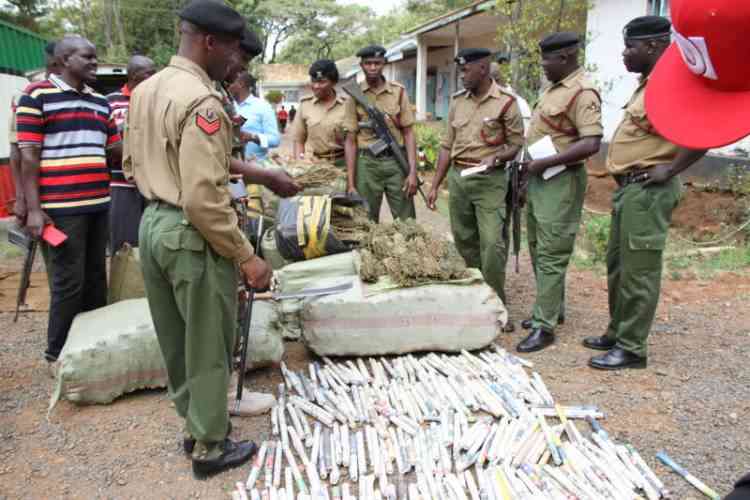By Phares Mutembei
As soon as the bell rings to announce the end of the day’s lessons at a mixed boarding school in Nairobi, a group of girls make a beeline for the toilets. Their hurry has nothing to do with a pressing call of nature.
A few cram into a toilet and from a concealed crevice in the wall, they extract sticks of cigarettes which they proceed to light. Plumes of smoke rise, as a sentry stands guard at a vantage point, on the lookout for a teacher, prefect or other uninvited guests.
What is happening in the girls’ toilet is also happening in the boys’. “I could not concentrate anymore, I was really thirsty for a fag,” says Mutabari, a Form Four student, exhaling with visible satisfaction.
Once done they file out and join others in their cubicles where they brush their teeth.
Sell to girls
The boys confide to The Standard that they hide the cigarettes in the toilets, and retrieve them when the urge for a smoke strikes, usually during the breaks.
“Yes, we always pass the cigarettes to a few of the girls, at a fee, of course. We buy cigarettes when we go out of the school compound and hide them in our socks. There are a few who have hair long enough to hide a stick or two,” he divulges. After smoking they usually chew banana leaves because its juice disguises the smell, they say. If the statistics of tobacco use among school children is anything to go by, this scene is replayed in many schools across the country.
The latest reports say 9.8 per cent of school children have acquired the smoking habit, an increase from previous years. According to the Kenya Global Youth Survey done in 2001, 7.2 per cent of school going children aged between 12 and 15 were smoking, while 8.5 per cent used other forms of tobacco.
Worry parents
A similar survey carried out in 2007, six years later, revealed that there was a 43 per cent increase in overall tobacco use among children.
The rate of smoking among school going children went up by 77.8 per cent within the period — and particularly among girls.
The recent global survey found that 40 per cent of cigarette smokers in Kenyan schools are girls, a fact that should worry parents, schools and health officials, among other concerned parties.
Kevin Kirimi has just completed high school and says at his former school, smoking just before commencement of lessons, during breaks and at night, was the norm.
“I always felt that I belonged to the minority of non-smokers and the temptation was great. Luckily, I didn’t.”
Another student James says he started smoking in Form Two and over the years, the intake per day has increased.
Stay informed. Subscribe to our newsletter
“I wasn’t pressured by my friends at school to start. In fact, I started on my first stick at home. It just looked ‘cool’ to do it. When I was younger, I used to put a biro between my lips and pretend to smoke. I looked at myself in the mirror and thought I looked really cool, little did I know I was getting myself into hot soup. Now I wish I hadn’t started because the habit is surely but slowly killing me.”
Another student swears that a teacher drove her into the habit when she was in Form One.
Bulged with smoke
“I saw our maths teacher standing in the field, smoking. He took puffs and his cheeks bulged with smoke. Then smoke came from his nostrils and his mouth as he exhaled. He came into the classroom and he showed us so many calculations, so I thought the cigarette gave him power to so easily work out sums. I was having a problem with maths and I thought smoking would help me,” says the Form Three student.
Esther Charagu, the headmistress of Gladys Girls’ High School in Nairobi, says, “Students are cunning so it is hard to identify the smokers. We depend on prefects and other students to inform us about this behaviour. The other students genuinely want their friends to stop bad habits such as smoking or drug abuse.”
Charagu adds: “In our society, we haven’t embraced the idea of girls smoking, but they are doing it. Children smoke because of careless parents, neighbours and other relatives or friends. There is no point in telling a child smoking is bad, yet you send the same child to the shop to buy you cigarettes. I think there should be a stiffer law against sending children or selling to the child,” Charagu tells The Standard.
Duncan Nyongesa, a high school teacher in Nairobi, says, peer pressure, especially at Form Two, is a factor that may lead a student into smoking.
The National Tobacco Control Action Plan 2010-2015, seeks to curb the growing trend of children acquiring the habit.
 The Standard Group Plc is a
multi-media organization with investments in media platforms spanning newspaper
print operations, television, radio broadcasting, digital and online services. The
Standard Group is recognized as a leading multi-media house in Kenya with a key
influence in matters of national and international interest.
The Standard Group Plc is a
multi-media organization with investments in media platforms spanning newspaper
print operations, television, radio broadcasting, digital and online services. The
Standard Group is recognized as a leading multi-media house in Kenya with a key
influence in matters of national and international interest.
 The Standard Group Plc is a
multi-media organization with investments in media platforms spanning newspaper
print operations, television, radio broadcasting, digital and online services. The
Standard Group is recognized as a leading multi-media house in Kenya with a key
influence in matters of national and international interest.
The Standard Group Plc is a
multi-media organization with investments in media platforms spanning newspaper
print operations, television, radio broadcasting, digital and online services. The
Standard Group is recognized as a leading multi-media house in Kenya with a key
influence in matters of national and international interest.









